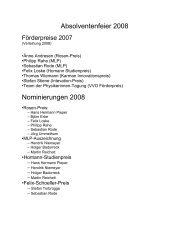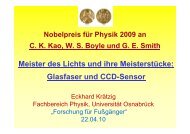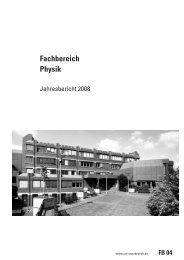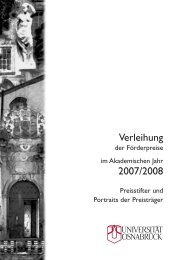Universität Osnabrück, Graduiertenkolleg Mikrostruktur oxidischer
Universität Osnabrück, Graduiertenkolleg Mikrostruktur oxidischer
Universität Osnabrück, Graduiertenkolleg Mikrostruktur oxidischer
Erfolgreiche ePaper selbst erstellen
Machen Sie aus Ihren PDF Publikationen ein blätterbares Flipbook mit unserer einzigartigen Google optimierten e-Paper Software.
GRADUIERTENKOLLEG MIKROSTRUKTUR OXIDISCHER KRISTALLE 15<br />
Electron spectroscopy and magnetism: Investigations on molecular<br />
magnets and rare-earth compounds<br />
Start of the project: 01.01.1999<br />
Dipl.-Phys Sorin Gheorghe Chiuzbăian<br />
Supervisor: apl. Prof. Dr. Manfred Neumann<br />
Summary:<br />
The magnetic properties of matter are in a direct connection with the electronic structure of the materials. However,<br />
this link is far from being completely understood. By investigating the electronic structure with spectroscopic<br />
methods and performing magnetic measurements, we were able to achieve a better understanding of the<br />
magnetic behaviour of the materials.<br />
We have focused our attention on two classes of materials: molecular magnets containing 3d-transition metal<br />
atoms and RM5 rare-earth compounds.<br />
State of art:<br />
In the recent years, special attention was paid in our group to the magnetic materials and to the spectroscopic<br />
features of the spectra due to the magnetic properties [1]. Thus, in the case of transition metal oxides [2], rareearth<br />
oxides [3] or Heusler alloys [4], it was possible to find reliable connections between the magnetic properties<br />
and the spectral features of the materials. The actual studies are a natural enlargement of these interests.<br />
The molecular magnets are a class of magnetic materials consisting of 3d-metal atoms trapped in cluster structures<br />
inside of organic or inorganic molecules [5]. It is an attractive subject in understanding the magnetic interactions<br />
at the microscopic level [6]. Experimental investigations of the electronic structure of the molecular<br />
magnets are practically inexistent. They also can serve as an important achievement to our previous results on<br />
transition metal-oxides due to their molecular structure which involves particular metal-ligand interactions. We<br />
have investigated a ferric-wheel by using XPS and shown that the final state effects can play a more decisive<br />
role in influencing the photoelectron spectra in comparison to the 3d-transition metals. In order to clarify the<br />
electronic structure, we have performed very recently investigations with synchrotron radiation. The late results<br />
are still under discussion. Additional molecules are under investigation.<br />
We have investigated the La(Ni,Cu)5 series by using X-ray photoelectron spectroscopy (XPS) and performed<br />
additional magnetic measurements in a wide temperature range. We have shown, for the first time, that these<br />
materials have to be considered as non-saturated spin-fluctuations systems [7]. The LaNi5 compound was traditionally<br />
considered to be an exchange-enhanced paramagnet [8,9].<br />
We have investigated compounds in the Gd(Ni,Al)5 series and shown that the Ni 3d-band in these compounds is<br />
sensitive to the local environment, showing a large variety of magnetic behaviour [10]. The magnetic properties<br />
were discussed in terms of the spin-fluctuation theory [11].<br />
Experimental results und discussions:<br />
1. Molecular magnets<br />
Ring–shaped clusters have gained a lot of attention as attractive models for one-dimensional magnetic materials.<br />
The synthesis and magnetic properties for even-membered Fe(III) cyclic clusters containing 6-18 ions have been<br />
reported ([12] and the references therein). Recently, new hexanuclear clusters containing an alkali ion (Li or Na)<br />
were reported [13]. The alkali ion placed in the center of a hexagonal wheel formed by Fe(III) ions plays an<br />
important role in stabilizing the structure and influences the Fe-O-Fe angles. The S = 5/2 spins are coupled antiferromagnetically<br />
in the sense of a negative coupling constant . The magnetic coupling results in a total cancellation<br />
of the spins and gives a Stot = 0 ground state.







